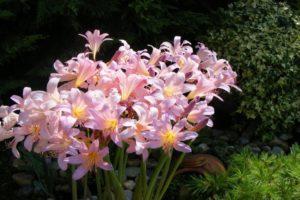Description of the best varieties of tree lilies, planting and care in the open field
Surely, every gardener would dream of growing an unusual lily flower that looks like a tree on his site. It should be noted that such a culture does not exist in nature. A tree is called any variety of lilies, which, subject to certain rules of agricultural technology, is able to achieve high growth. Often in gardening stores, the buyer is attracted by a loud name, but this is nothing more than a marketing ploy. However, it is quite possible to grow a lily resembling a tree on the site; for this, they study which varieties are the tallest, how to plant them correctly and the subtleties of caring for the plant.
What is a lily tree
Lily-tree is not a specific, artificially bred cultivar, but simply a generalized name for representatives of this family, capable of reaching high growth under certain conditions, almost like a tree. The hybrid, characterized by its huge size and called Goliath, was bred by Canadian breeders. During the flowering period (which happens once every 5 years), the flower-tree is covered with huge buds, which exude a delicate aroma and have a variety of colors.
The perennial bulbous plant has hollow stems and heart-shaped leaves. Lily flowers are different in shape - turban, goblet or long-tubular. But all of them are kept on very powerful stems, somewhat reminiscent of the branches of young trees. The diameter of the flowers of lilies-trees is impressive - about 30 cm, they bloom in the middle of summer and delight the eye throughout the month.
Popular representatives
Among the many hybrids of lilies, there are representatives that reach 2 meters in height with proper care. For the first time the description of such crops appeared in the catalog of the Dutch company Breck's LLS. However, this is not a new variety, but the same OT-hybrids of lilies, however, differing in a more powerful stem and faster growth. They have been repeatedly improved and refined, improving their characteristics.
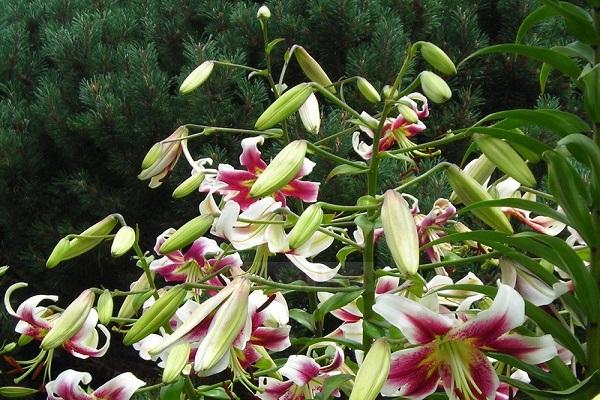
If the gardener decides to grow a lily tree on his site, it is recommended to opt for one of these hybrids:
- Scheherazade. A tall hybrid was obtained by crossing the eastern and tubular varieties. Only with proper care does a lily turn into a mini-tree the height of a human being. Scheherazade flowers reach a diameter of 27-30 cm and are cupped.In addition to the intoxicating aroma, lily buds have a wide palette of shades: there are yellow, red, orange, and pink representatives.
- Anastasia. On average, the culture reaches 2 meters in height and has rather large buds (about 30 cm). Among all OT hybrids, Anastasia is characterized by gardeners most positively. Due to the unpretentiousness of the plant and the wonderful aroma of flowers, it is grown commercially for cutting into bouquets. Another plus of Anastasia is the increased resistance of the lily to transportation.
- Donato. The color of the huge lily buds is purple-red and only on the neck is a yellowish color. It reaches a height of 2 meters, but only with proper care.
- Preti Wumen. Another representative of tall OT-hybrids with a funnel-shaped flowers. During the flowering period, the fragrance of lilies is felt far beyond the site.
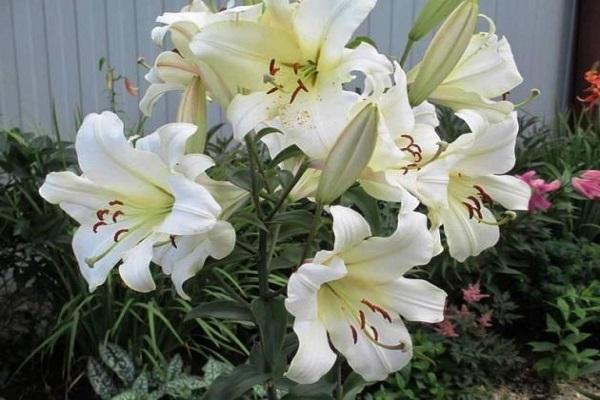
Advantages and disadvantages
Lily trees have not only advantages, but also some disadvantages that the gardener evaluates even at the stage of growing planning.
The indisputable advantages include:
- Spectacular appearance of a lily tree.
- The huge size of the flowers.
- Bright and rich aroma of buds.
- Powerful peduncle capable of holding up to 30 flowers.
- The ability to grow and develop even in acidic soils.
- Early start of the growing process.
The disadvantages of growing such crops include:
- The need for a spacious area.
- Compliance with certain rules of care.
- Sensitivity to the close occurrence of groundwater.
- The need to create support.

Growing features
From the right place for growing a lily tree and the preparation of planting material, it primarily depends on what height the culture will reach.
Location
Lily loves sunlight, but it should be diffused. Direct rays will provoke foliage burns and burnout of buds. In addition, a place is selected protected from drafts and gusts of wind, otherwise the tall stems of the plant will not withstand such an impact and will break.
Despite the fact that the culture loves moisture, close-lying groundwater will lead to root rot. Gardeners share this trick - undersized flowers are planted around the lily, which protect the tree from sunlight and prevent moisture from evaporating.
A slightly acidic and neutral soil is ideal for growing hybrids, and lime soil is highly discouraged. The land must have increased water permeability and be nutritious. Otherwise, provide an additional drainage layer.
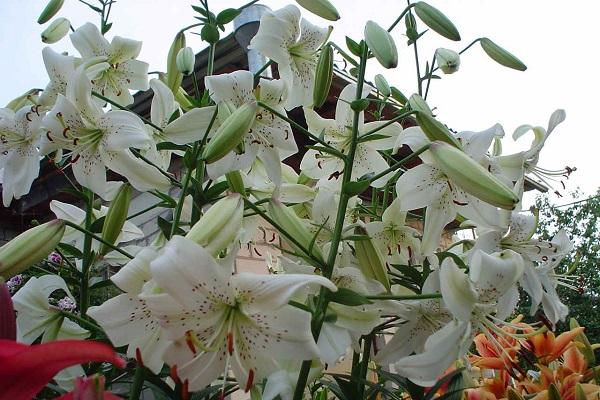
Planting material
Bulbs of tall lily hybrids are purchased only in specialized stores, where the gardener will be provided with a certificate of conformity. Since planting material is not cheap, in spontaneous markets there is a high probability of running into scammers who pass off ordinary lily bulbs as OT hybrids.
Before planting the lilies are prepared - the bulbs are examined for mold, rot, dry scales. Such material will not produce full-fledged plants. The bulbs are pre-soaked in a slightly pink solution of potassium permanganate; it will also not be superfluous to treat each instance with a growth stimulant.
Landing technology
Lily trees are planted both in spring and autumn. In the first case, it is recommended to do this in the last days of April or in May. In the second, the first half of September is suitable, so that the bulbs can take root and adapt in a new place before the onset of cold weather.

The algorithm for planting hybrid trees in open ground looks like this:
- A layer of sand is poured at the bottom of each hole, its depth should be about 20 cm.
- Gently press the bulb into the prepared hole and cover it with fertile soil on top.
- Lilies are poured abundantly with non-cold water.
- The surface is mulched using peat or dry leaves.
When planting, the distance between the lilies of 1 meter is observed so that the plants do not have to compete for nutrients and moisture.
Tips for the care of tree lilies
It depends on the observance of agricultural technology, what height it will be possible to grow a lily tree and how effectively it will bloom.
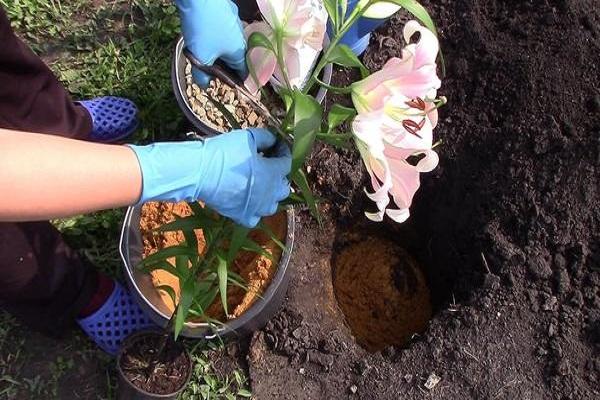
Watering
When moistening lily trees, regularity and measure are observed. Despite the fact that the culture is moisture-loving, especially during the period of budding and flowering, excess moisture negatively affects the state of the root system. The optimal irrigation frequency is considered once a week. It is recommended to increase the number of watering only in very dry weather. Then it is done twice a week.
Top dressing
Without the introduction of nutrients, it will not work to grow a lily resembling a tree. Fertilizers are applied from the moment when the first leaves appear on the plant. Both mineral and organic compounds are used. They also purchase complex formulations designed specifically for bulbous flowers in gardening stores. To achieve the required height of the lily tree, the culture is periodically fed with growth stimulants.

The only thing that is strictly forbidden to fertilize a hybrid lily is fresh manure. Such feeding will provoke an outbreak of fungal diseases, and the plant will have to be destroyed.
The last time fertilization is applied in mid-August, before preparing the crop for winter.
Mulching
Laying a mulch layer is especially advisable in the southern regions. This prevents evaporation of moisture from the soil and makes it possible to reduce the amount of irrigation. Mulch is also a natural weed barrier, so there is no need for frequent weeding. Peat, humus, fallen leaves or sawdust are used as mulch for lilies.
Pruning
When preparing for winter in the fall, it is not recommended to cut the lily stems at the root. Leave a minimum height of 10-18 cm.
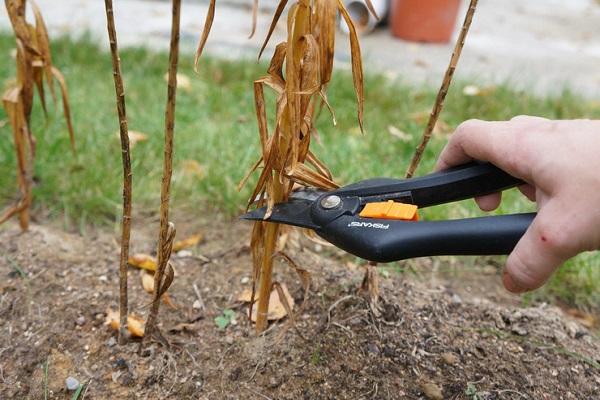
Support
Without a strong support, it will not work to grow a full-fledged lily tree. The stem will simply break under the weight of the buds. Wooden pegs or plastic pipes are used as support.
Wintering
In the first year of planting, they are covered with plastic wrap so that immature plants do not freeze. In subsequent years, it is enough to carry out autumn water-charging watering and cover the lilies with spruce branches or a special covering material, for example, lutrasil.
Diseases, pests and methods of dealing with them
The most dangerous for the lily tree are the following diseases and pests:
- Gray rot. The reason is excess moisture and the presence of weeds near the plantings of lily hybrids. The parts damaged by the disease are removed, and these places are treated with a fungicide, for example, "Fundazol".
- Fusarium. A fungus that develops on bulbs and roots, with high humidity and excess nitrogen in fertilizers. Potassium permanganate solution is effective for treatment.
- Spider mite. It settles on lily foliage and drinks juices from the culture. It is effective to fight with green soap solution or any insecticide, for example, "Aktara".
Reproduction
The lily tree is planted in several ways.

Scales
The upper scales are separated from the mother bulb, put them in a plastic bag with a substrate and wait for the germination of roots. Several holes must be made in the bag so that the lilies do not suffocate.
Stem cuttings
The fastest method, which involves separating the green cutting from the lily stem in spring. It must be treated with "Kornevin" and planted on a prepared bed. At first, young lilies are covered with polyethylene or glass.
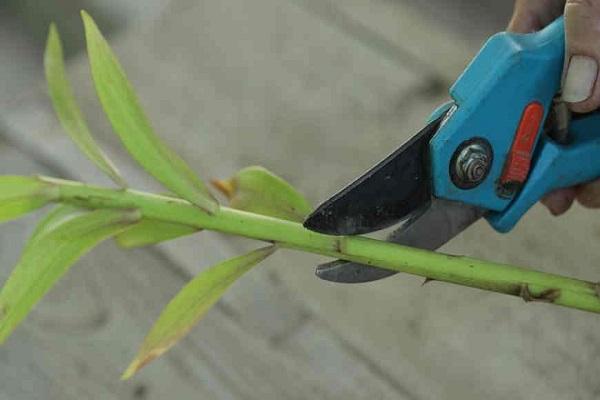
Seeds
This is the most labor-intensive and time-consuming method; it is more often used by breeders to breed new lily hybrids.
By dividing the nest
Near the mother bulb, daughter ones are formed over time, which are used for further reproduction of tree lilies. The method is simple and suitable even for novice gardeners.
Examples in landscape design
The lily tree itself becomes the main attraction and decoration of the site. Low-growing plants are selected for the company. Compositions of lilies with creeping cultures, for example, loosestrife or tenacious, also look beautiful.

